You know what’s weird? Now that superhero movies are so popular, I keep hearing people say things like this: “Objectification is equal now! Guys have to be just as attractive as ladies on film, and have to go shirtless!”
And then I tilt my head sideways like a confused puppy because… that’s not how objectification works. We all know that, right?
I get where this sentiment is coming from, of course. It’s not just that we see more objectifying of men for the female gaze (hey there, Magic Mike XXL!); our definition of the “ideal male body” has altered in recent years to play more into female desire. You know, Arnold Schwarzenegger and Sly Stalone were tough-looking dudes when they were leading action men of the 80s, but it’s safe to say that most women weren’t weak at the knees over those guys. They were huge and unapproachable, much like the names of the characters they played—Rocky, the Terminator. They were male power fantasies meant to appeal to male fans.
The advantage of guys like Chris Evans and Tom Hiddleston is that they are less intimidating in their physiques and seemingly sweet, no matter how much damage they can do on a fictitious battlefield. They have an element of charm that action movie guys, from cowboys to bodybuilders, didn’t worry much over in the past. Even the bigger buff guys today seem super cuddly personality-wise; practically everyone loves The Rock and Vin Diesel.
It’s not difficult to figure out why this new brand of leading man is popular—having a mixed appeal to both male and female viewers is going to grant you a bigger audience. But throwing in a scene of a shirtless guy (or allowing the camera to linger on his bum)… does that really mean that we’re getting equal opportunities for objectification? Are men and women the same now in the eyes of Hollywood?
Here’s the thing: Objectification is not just a question of who has to look prettiest on film. It’s also a question of how these pretty people are presented to us. Is this person a fleshy equivalent of wallpaper or the coveted Main Character? What are they doing when their shirt rips and we glimpse skin? Because being objectified is primarily about being an object to the viewer. And if you’re a multi-faceted character, it’s going to be harder for people to ignore your personhood and think of you as a piece of sexy scenery.
As it appears right now? Sure, male actors have more rigorous standards in the looks department than before. But this new brand of objectification never makes them out to be cardboard cutouts for staring at. In fact, the current realm of male objectification is primarily concerned with making sure that the audience engages with their actions and humanity, even while we’re staring at their abs.
Sound improbable? Here are a few current examples—
Everybody loved Guardians of the Galaxy, and Chris Pratt got a heavy round of applause from fans for getting fighting fit to play Peter Quill. He looked handsome, to be sure, but does anyone remember his single shirtless scene in the film?
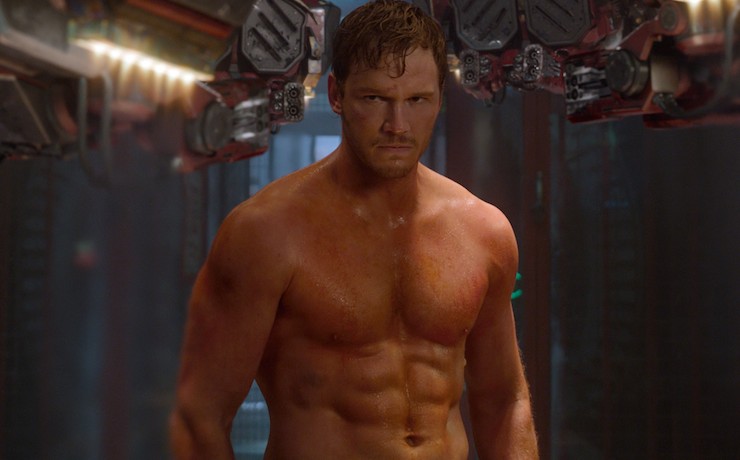
Wait. Wait, he’s getting hosed off in prison. And he doesn’t look happy about it either. Kinks are a thing, and this might be a specific fantasy for some, sure—but it doesn’t change the fact that something awful is happening to Quill, and we’re meant to engage with that as much as his lack of shirt. He can’t simply be eye candy because we have to consider his surroundings and their affect on him at the same time that we’re appreciating his love of sit-ups.
What about our poor woobie Bucky? The Winter Soldier had everyone crying buckets as he tried to remember his long-lost childhood friend. Bucky had an even harder time of it than Captain America, forced to kill for Hydra (and get thrust back into cryo-freeze) over the course of decades, brainwashed and alone. When do we get to see more of fandom’s favorite Almay eyeliner-loving fella?
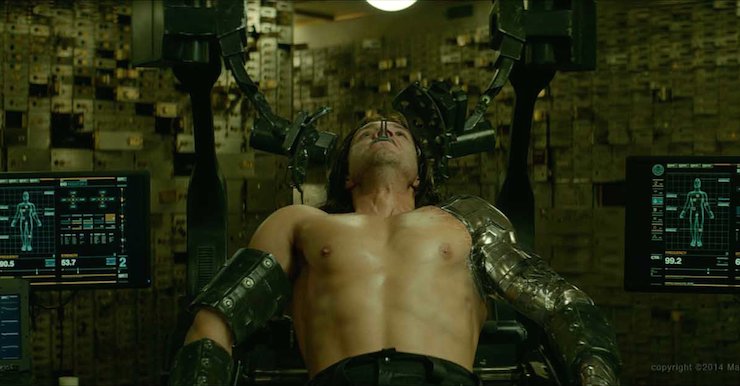
Oh. Oh, good god. It’s right before they put him through another round of shock therapy to erase his reemerging personality. So while you’re busy considering how well that metal arm goes with his pecs, you’re also reminded of the regular torture this man has endured at the hands of his captors. His personhood is reenforced to the audience as it’s obliterated by Hydra once again.
Hey there, Daredevil. Charlie Cox is a gorgeous man, okay? He really is. And we get more than one shirtless scene for Hell Kitchen’s vigilante in the lauded Netflix series.
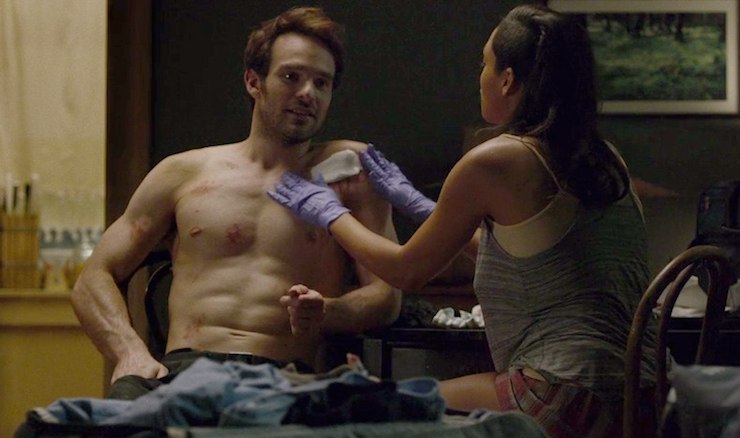
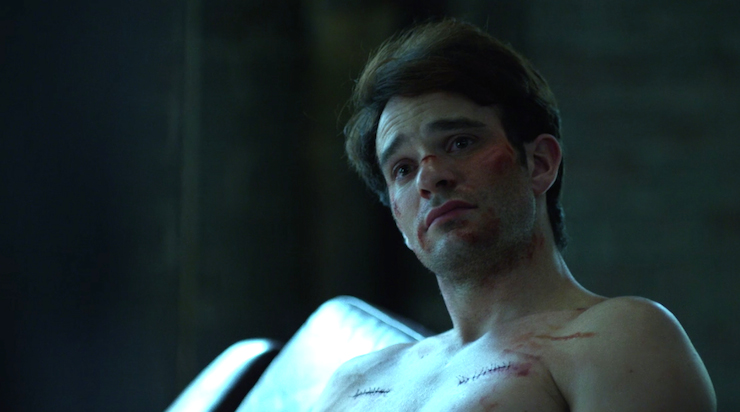
But practically every time we view Matt Murdock sans clothing, he has been beat to hell. He’s recovering from massive injuries, he’s getting stitched up, he’s swollen and bloody and near-to-tears, or plain exhausted. And it’s a common trope, of course (hurt/comfort is a whole subset of fan fiction for a reason), but it’s also preventing us from simply staring and enjoying. When Matt Murdock isn’t wearing his shirt, it’s because he’s in unbelievable pain—and the audience has to think about that. They have to acknowledge what he’s putting his body through every times he dresses up as Daredevil. When Matt Murdock is shirtless, we’re meant to think about what makes him a hero.
What about Deadpool! Deadpool will fix everything, right? The film was Rated R, which means we actually get to see something more than a six-pack. Wade Wilson is gonna fix this up for us:
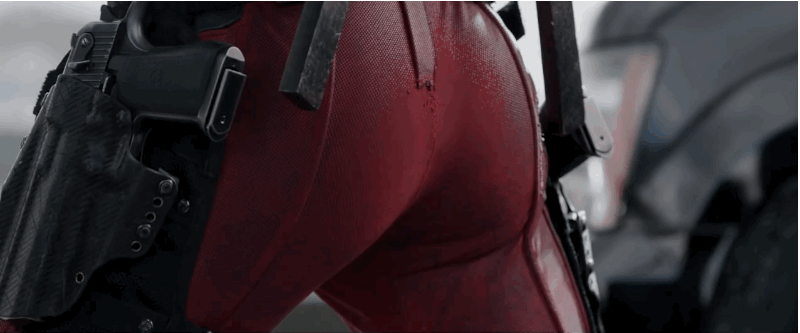
We see his naked butt! It’s out there! (I’ll get you more relevant screencaps once the Blu-Ray is out, but for now we’ll have to settle for the above butt GIF.) Wait, but we see his bare posterior in the very scene where he passes out, thereby learning that he has cancer. So our one “fun” moment of dude-butt is waylaid by a horrible, deeply sad revelation.
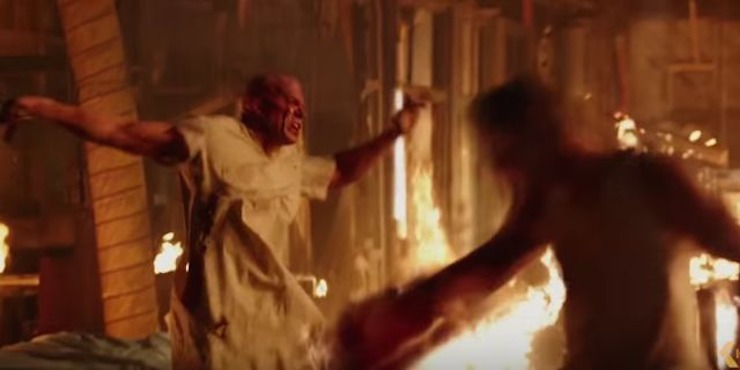
He gets totally naked, too, though! Whoa, but it’s not for the purpose of titillation at all, it happens when Wade is fighting to break free from the installation that has tortured and transformed his entire body in order to make him into a slave. It is a painful formation sequence, where Wade is forced to endure even more suffering as a building burns down around his ravaged body. When we see full frontal male nudity in a superhero film, it isn’t about giving the audience a thrill—it’s meant to highlight everything that the (anti)hero has to endure.
And that very same movie proves my point in the other direction as well. Because when we see female nudity in Deadpool? They are strippers.
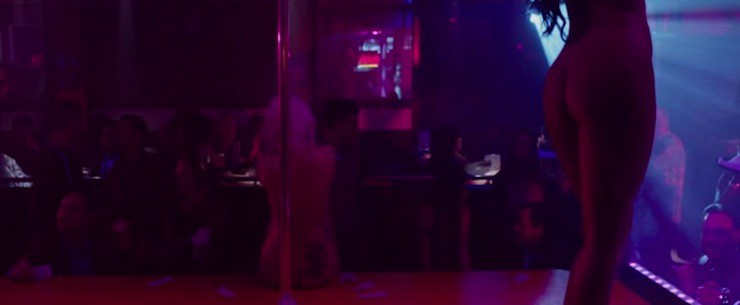
Yup. These women are not meant to be thought of as people—they are set dressing. There’s not even a good reason for us to see them plot-wise; though this is meant to be where Wade’s girlfriend Vanessa works, the film never needed to show the entirely of the club, or any of these women naked. (Tellingly, Vanessa herself is clothed in this scene. She is mostly naked earlier in the movie when she and Wade are having sex, which doesn’t much contribute to her character at all, though it is a funny montage.)
Oh hey, and here are some set photos for April O’Neil in the upcoming Teenage Mutant Ninja Turtles sequel:
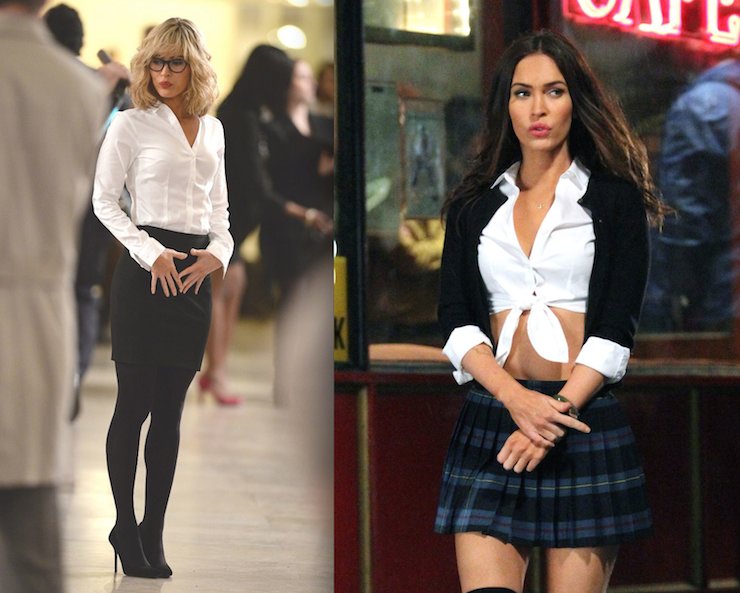
She’s in disguise as a blond! Aaaaaand then she takes off the wig, undoes some buttons and ties up her shirt to be certain that she’s showing maximum cleavage and midriff, and she’s wearing… thigh-highs and a plaid schoolgirl skirt. Because this is how very professional reporters change undercover costumes? (And don’t say “it’s Michael Bay, what do you expect?” That doesn’t mean it gets a pass. In fact, it gets less of a pass because of how many people go to see his films.) This does not contribute to April’s personhood. It’s there to remind you that she’s not a character you have to take seriously. She is there to dress like a very boring sex fantasy. That is the whole reason she’s in the movie.
What about Bryce Dallas Howard’s character Claire in Jurassic World? Sure, objectification isn’t going to go too far in the family film, but the ways in which she gets “dressed down” are particularly telling. For those who don’t remember, she starts the film like this:
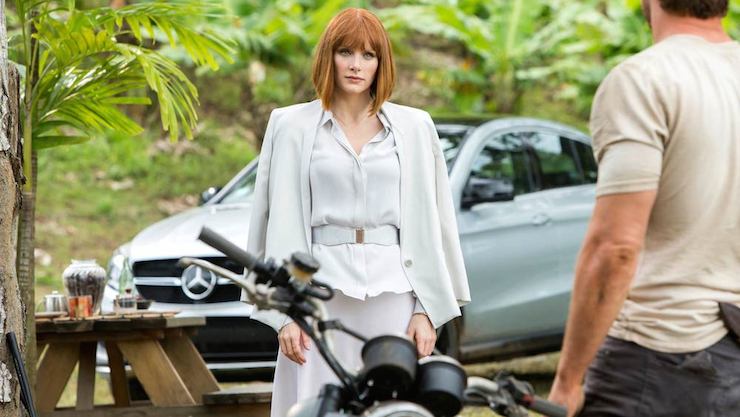
Super professional if not at all practical for working at a tropical amusement park with live animals. (I’m not saying she should have been dressed like safari guide, but the stilettos, the long unworkable skirt, and the white button-down blouse? Does she never sweat or walk anywhere? In 500% humidity?) As the movie continues, we get something more like this:
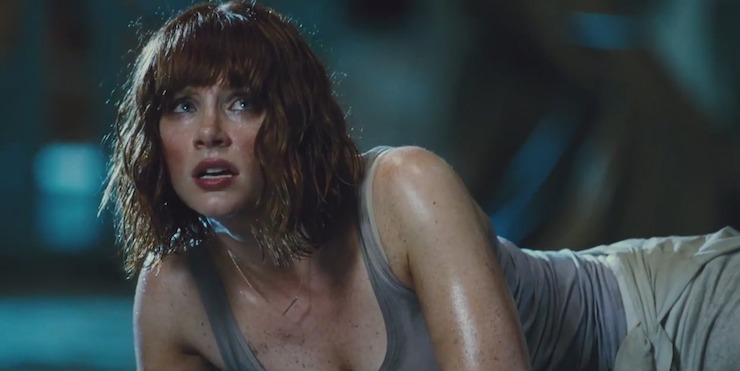
So her hair gets all “naturally” wavy and tousled (though her bangs stay magically perfect), she forgoes her extra accouterments for her underlayer tank top, and though the above pic doesn’t show it, her skirt rips all the way up above her knee. More functional, for sure. It’s not super-sexy, but meant to be appealing in a “sweaty action heroine” sort of way. It’s still a far cry from Dr. Ellie Satler’s completely functional, no-nonsense garb in the first Jurassic film.
But the part that really stings is what this slow undressing means in regard to Claire’s character; after all, she is not heroic in the standard sense up until the very end of the film when she calls on the T. Rex to save her family. And this gradual peel-back of her clothing layers just serves to highlight out how ill-conceived her wardrobe is, how disconnected she is from the living creatures in the park that she holds no respect for, how cold and business-minded she is, how distant. The point is that as Claire gets “sexier” looking, she also becomes less of a stereotyped “frigid bitch.” Which is plain insulting.
And that’s without even considering this horrible deleted scene from the film, where she is told by Chris Pratt to rub dinosaur shit all over herself to “get rid of the smell of her vanilla lotion.” Yeah, that was actually in the script and filmed, and I can’t even touch that, it’s too gross on multiple levels:

So, you know, there’s a marked difference here.
There are very few examples of men in these stories being objectified just for the sake of it—or in a way that directly undermines their power and authority as a heroic figure. Thor: The Dark World is a notable exception. (Sponge bath. No reason. Just ’cause.) In fact, I’d go so far as to say that Thor: The Dark World as an entire film caters beautifully to female gaze and female fandom at large. Jessica Jones is another good example, and notably also caters to the female experience and gaze. So we’re meant to look at Luke Cage and find him attractive, but when Jessica takes her pants off, it’s usually because she has to pee—not exactly the sexiest of actions. (Pointedly, the one time we’re meant to wiggle our eyebrows over Jessica going pants-less, it’s because she’s flirting… with Claire.)
But more to the point, these are merely recent examples. When you look back over the past decade or more, this particular mode of male objectification is all over the place. It’s our new normal. Let him take off his shirt—but only if something deeply important or painful is happening, something that reminds you of why this guy is a hero. We’re starting to see it for female characters in more recent years, but it hasn’t caught up yet. It’s still thought of as a subversion of the trope.
So let’s maybe take a step back on the “equal objectification” front. Though we’re seeing a lot more in the realm of biceps and cut hip muscles, it’s still a far cry from how women are depicted.
Emmet Asher-Perrin is completely fascinated by how many superhero films use this male objectification trope (nearly ALL of them), to the point where she’d like to deliver a class on it complete with a Powerpoint presentation or something. You can bug her on Twitter and Tumblr, and read more of her work here and elsewhere.











Yeah, in truth, I don’t see why we would want ANYBODY to be objectified. Which is not to say one can’t appreciate the physical aspects of a person, but like you said, there’s a marked difference in the way we are invited to perceive male characters and female characters.
That said, I’m not sure how comfortable I’d feel about some of your initial examples if the gender were flipped – maybe because there’s already so much baggage around the way we view women/violence/sexuality, but I don’t want to see scantily clad women who are also in the process/aftermath of being hurt/tortured/hosed down. (Frankly, I don’t really want to see men that way either, with the expectation that I will find it sexy). I mean, I think it can be handled with respect certainly, but I worry that a lot of people would try to make it titillating which is…not cool to me. Which I suppose is your point – that with men the scene is NOT generally about just being sexy.
So I knew I was going to disagree going in and I was not disappointed. The females you choose are some of the worst currently and are generally bad though you really do leave out that they are still multifaceted characters and I am simply going to disagree philosophically that having a pretty person (male or female) in the movie because they are pretty is a bad thing. I also disagree that Rocky and the Terminator were not supposed to appeal to women – they may not have but at the time certainly the women I knew were looking for big strong men. The strong silent type is a trope for a reason and it isn’t a male fantasy. I mean look at romance novels that are read by women and the way the men are described there.
The problem comes when real fleshed out characters are also sexy simply for being sexy and people act like that is bad. Best example is Quiet from Metal Gear Five. Incredibly strong military character. Game play wise makes missions almost a walk in the park and you see her in a cut scene shoot a plane’s pilot from a helicopter while BOTH the helicopter and the plane are moving. The sniping of the terrorist in the ship from another ship that everyone was so amazed by a few years ago on an epic scale. But she still dresses sexily and a model was cast as the character simply because she was attractive. So everyone was up in arms. This was wrong. She is a multifacted character – one facet was she was incredibly attractive and yes that was a nice facet. That doesn’t mean the other facets are not there and it doesn’t make enjoying the attractive facet bad.
I don’t watch movies to see hunky actors with little or no clothing. When I’m interested in movies, it’s usually for the story or because my friends are fans of whatever we’re seeing.
I can do without the eye candy of any variety and I’d rather have movies populated by people who look like average human beings instead of airbrushed superstars. I remember being intrigued at the difference between the appearances of American and British actors when I first started watching older British films and movies. Those feel more like a slice of the real world than many contemporary works where we’re expected to believe that the world is populated only by the gorgeous.
Great article, Emily!
I will always advocate for Starz’ series Spartacus. It was one of the few shows I felt had quite a lot of objectification for male, female, straight, and gay gazes. But the copious amounts of male and female nudity were also presented in different fashions. When Spartacus, his fellow gladiators and the female house servants were naked in front of their masters, you were always reminded that they were slaves and it was terrible and demeaning. (They had a whole episode around this, too, called “Whore,” in fact.) But when the gladiators were hanging out together, just chilling in a bathhouse or sexing up each other or women, it was kinda cheesy fun.
Spartacus was Downton Abbey with gore. And it worked.
@5, LOVE THAT SHOW, and I agree with everything you said. There is even a marked difference in how non consensual sex and consensual sex is shown, with one VERY GLARING exception, and that exception is valid, IMO.
@2
I mean… your first sentence. I think you should reflect on that and perhaps do a little introspection.
@6. Aeryl
Which scene was glaring in Spartacus? I’m trying to wrack my brain and remember.
I like the article, but like @2 says, I think you missed a bit on the 80s action hero. They were objectified and as everyone remembers, a lot of those characters were painfully thin. I understand that there are different factors at play when we talk about the objectification of women, but let’s be honest, when Arnold came on to the scene, he could barely speak english, and they kept his lines to a miminum. He was literally only there to be a body.
Well I certainly wouldn’t claim to speak for all women, but I agree with Emily that most women don’t find the over-muscled look attractive nor the kind of characters Schwartznegger and Stallone played (in so far as they acted) at all attractive. Those films were made for men, they were male fantasies of being powerful, of winning despite the odds against you. Its a completely different thing to what most women find attractive. I can’t say I do remember lots of painfully thin action heroes, but it wasnt a genre that interested me, however the fact that I don’t remember thin action heroes does rather disprove the assertion that “as everyone remembers, a lot of those characters were painfully thin”.
As for the idea that you can see what women like from the strong silent trope, yes it used to be more common in romance novels, it is still there in some romance novels. However romance novels have always been far more varied than that and these days it really isn’t that common, because it isn’t what most women want even in their fantasies. Asserting that it is a common trope in romance novels merely illustrates your ignorance of the genre.
@7:
To be blunt, why? The person came into the article expecting that they would not be swayed. They were not swayed. This isn’t inherently a failing on their part. If I wrote a non-satirical article “Why Being a Nazi is Totally Awesome”, I imagine most people who read it would go into it knowing damn well what their opinion on the article would be, for example. So long as they read the article and examined its arguments, why shouldn’t they be honest?
Arnold Schwarzenegger and Sly Stalone weren’t the only action stars in the ’80s. Harrison Ford and Mel Gibson were considerably less large and muscular and I remember women swooning over their shirtless adventures. “Sexiest Man Alive.” Remember that? Yes, kids, once upon a time the grandpa from Star Wars with the crooked nose and the scar on his chin gave women the vapors — more or less.
I’m not disagreeing with the point of the article. Just keep in mind male stars have been objectified to varying degrees since the days of Rudolph Valentino.
@11:
Being honest is one thing. “So I knew I was going to disagree going in and I was not disappointed” is quite another. Why should the possibility of having your opinion changed by an opposing perspective be disappointing?
I’m pretty sure aFan was referring to their characterization, not their physique.
@8, The scene with Illythia and Spartacus. It was initially portrayed as consensual, to trick the audience into thinking it was the liaison he had agreed to with Licinia
“Because being objectified is primarily about being an object to the viewer. And if you’re a multi-faceted character, it’s going to be harder for people to ignore your personhood and think of you as a piece of sexy scenery.”
Why? How is it harder? Men have been objectifying real women they actually know and interact with since the dawn of time. So, yeah, I guess it might be technically harder for a viewer to objectify a fully fleshed out character than the equivalent of a 2D movie poster, but that’s like saying its harder to lift a peanut than a feather; both are still trivially easy. Its all about choice and what was modeled for you as a child.
Now, if we are talking about a writer/director/movie presenting a character for objectification, that’s a different scenario; one that’s entirely about the intention of the story’s creators. And there is definitely significantly more intention to use men as eye candy now than there was 30 years ago.
Such a fantastic article! I love it when a writer clarifies things so beautifully and with so many pertinent examples. Great job.
A few things:
Yes, @2 is the MRA/GG perspective that apparently EVERY SFF comment thread needs these days.
@12: Remember when Harrison Ford got all buffed up for Indiana Jones and the Temple of Doom? That was–kind of awesome.
As a gay man, I want to see more male nudity. I don’t think Chris Evans has taken off his shirt since right after his transformation in the first Captain America movie. We saw Ruffalo shirtless in Avengers 2, but nobody really cares, he’s not Evans or Hemsworth. (Kudos to the eye-candy scene in Thor 2 as well as his shirtless bath in the Waters of Time or whatever in Avengers 2.)
If you really want to see an objectified male figure, though, look no further than Daniel Craig in Casino Royale.
I agree that nudity for the sake of nudity is objectifying, set dressing, etc. But yeah, let’s be real here. In most movies men are nude for a reason, as the article illustrates. It is part of a scenario where nudity is likely or viable to enhance a theme or emotions of the scene. This doesn’t mean that the motive is audience arousal. But in 99.9% of cases female nudity is indeed pointless and purely meant to arouse. Sex sells. Anyone whining about male objectification in media gets a ridiculously huge eye-roll from me. When 99% of nudity in films over the course of 80 years features men running through the woods with their valuables hanging out of a torn Speedo, hanging stupidly on the arm of a powerful woman, or going full frontal so Leo DiCaprio can draw him like his French girls, then we’ll talk about objectification of men. Until then, such men are simply whining in order to have something to whine about. It’s pitiful and pathetic and not at all manly.
I’m generally in agreement, and I think the treatment of women in movies has still a long way to go before it reaches some sort of equality.
That said, there are two things I do disagree with:
1) The tortured, humiliated and naked male hero thing has been done for erotic kicks (of the non-vanilla denomination) since at least Tarzan (oh, remember Tarzan? He always showed a lot more skin than Jane or anyone else, for that matter) and Flash Gordon (who also showed a LOT more skin than Dale Arden). And Chris Pratt does not only appear shirtless in that scene, he goes full frontal monty (well, in the DVD anyway, and there’s a LOT to see there). Granted, there still has to be some plot contrivance to allow a man to appear naked on screen, which is the point of the article. Female nudity is thrown into the mix in a lot more gratuitous, casual manner.
2) The vanilla lotion thing seems to me perfectly justified. Most women I know (but not all) would have dressed more practically for a safari, but they would still wear perfume/lotion/whatever. Of course a similar situation is handled in a more gender-equal way in Del Toro’s Mimic, but in truth women wear a lot more fragrance that men. That’s hardly more than statistics.
@20 ” Until then, such men are simply whining in order to have something to whine about. It’s pitiful and pathetic and not at all manly.”
Just because men are objectified to a lesser degree and at a lesser volume, it doesn’t mean they have to like it, or let it pass until some parity is reached and men are treated equally as poorly. Any man raped doesn’t have to sit in the shadows with his pain until society reaches some magical tipping point where men are raped in equal numbers as women either. Just because one problem is clearly bigger doesn’t mean we have to let it expand to equal revulsion.
Men that speak out against it are not whining. They are doing the exact same thing many women are doing when they protest objectification (by both men and women). Men have plenty of other things to speak out about, and if they choose this specific thing to focus on, they deserve attention and respect, just like women.
I am interested in your full definition of what constitutes “manly” though. Please expound what you, as not a man, think are the generic and universal traits every man must have or be considered “pitiful and pathetic”.
I’m surprised your comment didn’t get removed by the moderation policy, but since we’re here…
@14 thanks, I was referring to characterization.
The key is the turning people into an object, which doesn’t apply to the male actors referenced above but also doesn’t apply to female actors (other than maybe the strippers, I haven’t seen the movie so I don’t know). On the other hand, it definitely applies to the many meat sacks killed in commando/predator/rambo, etc.
Hmm.. I don’t know why you just figured it out now. LOL Male objectification started way back in the 1980s with Tom Cruise in Top Gun (the locker room scene was not in the original script. they added it so that women can ogle Tom Cruise) and Risky Business when Tom was dancing in his underwear. Then, there was Brad Pitt in The Legends of the Fall and A River Runs Through It.
What I’m saying is that though this article is great, and I’m glad that someone finally said something about it, seeing men as sex objects started way back in the 1980s not just the 2000s. And it did not start with Marvel Superheroes or sci-fi. It started in the Navy and in the Midwest. :-)
This is a disturbingly sexist reflection on objectification. One of the most troubling aspects of the representation of male nudity in mainstream cinema is its persistent linkage to degradation or humiliation. There must be a pretext for showing a naked man that will neutralize its impact. It cannot simply be for the sake of admiring male beauty, lest the film become “gay.” This is one of the most pernicious aspects of “phallocentric” culture, whose objectives have always been to control and manage male consciousness. Indeed, we seem to be still several decades away from any sort of liberation movement that would do for men what the women’s liberation movement did for women.